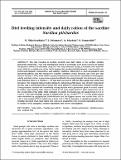Por favor, use este identificador para citar o enlazar a este item:
http://hdl.handle.net/10261/44556COMPARTIR / EXPORTAR:
 SHARE SHARE
 CORE
BASE CORE
BASE
|
|
| Visualizar otros formatos: MARC | Dublin Core | RDF | ORE | MODS | METS | DIDL | DATACITE | |

| Título: | Diel feeding intensity and daily ration of the sardine Sardina pilchardus |
Autor: | Nikolioudakis, N.; Palomera, Isabel CSIC ORCID ; Machias, A.; Somarakis, S. | Palabras clave: | Daily ration Feeding periodicity Sardine Sardina pilchardus Mediterranean Sea Aegean Sea |
Fecha de publicación: | sep-2011 | Editor: | Inter Research | Citación: | Marine Ecology Progress Series 437: 215-228 (2011) | Resumen: | The diel variation in feeding intensity and daily ration of the sardine Sardina pilchardus (Walbaum, 1792) was investigated based on 50 pelagic trawl hauls carried out during the period of thermal stratification (July 2007 and July 2008) and mixing (December 2007 and February 2009) in a coastal area of the North Aegean Sea (eastern Mediterranean). Concurrently collected hydrographic (temperature and salinity), plankton (chlorophyll a, microzooplankton and mesozooplankton) and fish parameters (somatic condition, sexual maturity and catch per unit effort of sardine, CPUE) were used to explain seasonal and inter-annual variability in feeding periodicity and daily ration. A piecewise regression fitted to the weight-length data indicated a significant inflexion point at a length of ~100 mm that was used to split the fish sample into adults and juveniles. The stomach fullness index (stomach content mass/fish mass) was strongly dependent on size, and a generalized linear model was used instead to standardize stomach content mass. During summer, sardine fed consistently during daytime with a prominent peak at around sunset. In winter, high feeding rates were recorded in the early night (first 6 h after sunset) but not in the second half of the night. Field estimates of gastric evacuation rate (R) ranged from 0.101 to 0.225 h−1 and were strongly related to temperature (T) (R = 0.075e0.038T, r2 = 0.785). Daily rations were estimated by applying the Elliott-Persson and the Eggers models and varied from 2.02 to 3.67% total weight (TW) in adults and 4.18 to 5.36% TW in juveniles. A significant positive relationship emerged when daily ration was regressed against the ratio of mesozooplankton biomass to sardine CPUE, implying a density-dependent rate of food consumption | Descripción: | 14 pages, 7 figures, 4 tables | Versión del editor: | https://doi.org/10.3354/meps09275 | URI: | 10261/44556 | DOI: | 10.3354/meps09275 | ISSN: | 0171-8630 | E-ISSN: | 1616-1599 |
| Aparece en las colecciones: | (ICM) Artículos |
Ficheros en este ítem:
| Fichero | Descripción | Tamaño | Formato | |
|---|---|---|---|---|
| Nikolioudakis_et_al_2011.pdf | 834,85 kB | Adobe PDF |  Visualizar/Abrir |
CORE Recommender
SCOPUSTM
Citations
40
checked on 19-abr-2024
WEB OF SCIENCETM
Citations
38
checked on 24-feb-2024
Page view(s)
645
checked on 24-abr-2024
Download(s)
106
checked on 24-abr-2024
Google ScholarTM
Check
Altmetric
Altmetric
NOTA: Los ítems de Digital.CSIC están protegidos por copyright, con todos los derechos reservados, a menos que se indique lo contrario.
